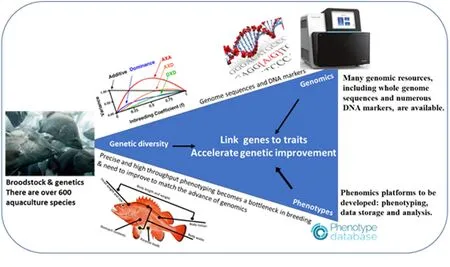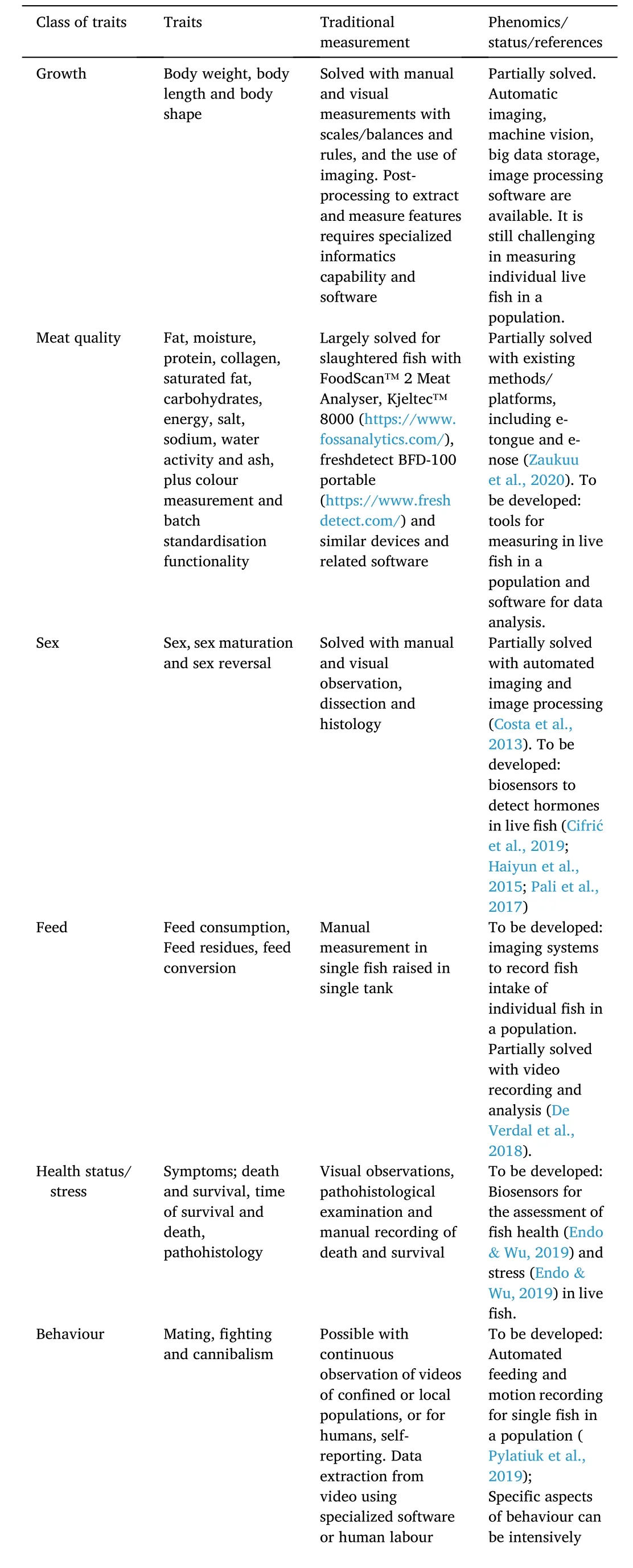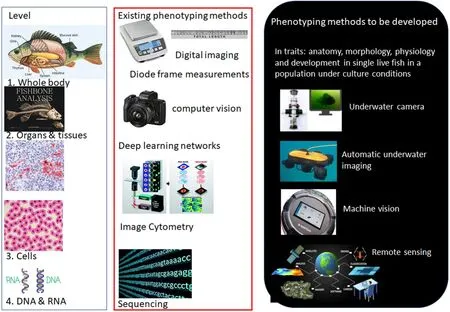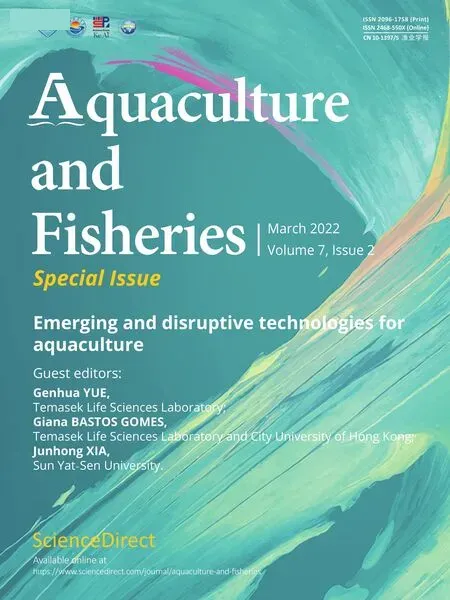Phenotyping and phenomics in aquaculture breeding
Guihong Fu, Yun Yun
aHunan Engineering Research Center for Utilization of Characteristics of Aquatic Resources, Hunan Agricultural University, Changsha, 410128, China
bSchool of Humanities, Nanyang Technological University, 48 Nanyang Avenue, 639818, Singapore
Keywords:
Aquaculture
Breeding
Trait
Behaviour
Measurement
A B S T R A C T
Due to the availability of genomic resources, including whole genome sequences and numerous DNA markers in some aquaculture species, genetic improvement of important traits has since moved on from conventional breeding to marker-assisted and genomic selection, or a combination of both. However, phenotyping has become the major bottleneck, which hinders the genetic improvement of fish. Although some phenomics platforms have been developed for the precise, rapid and non-invasive measurement of important phenotypes (e.g. growth traits)in aquaculture species, the phenomics platforms for most traits (e.g. disease resistance, stress tolerance,behavior) are still lacking. Recent advances in novel technologies, including automated imaging/machine vision,diode frame measurements and deep learning networks, will provide solutions to the development of phenomics platforms, including phenotyping, data acquisition and processing. In this article, we describe the concept of phenomics and its importance in fish breeding. We also summarise the status and challenges in developing phenomics platforms in aquaculture and propose suggestions in the development of these phenomics platforms.
1.Introduction
Aquaculture is the fastest growing sector in agriculture worldwide in the past a few decades (FAO, 2020). Due to the increase of human population size and improvements in the quality of life of human beings,the demand for high-quality seafood is expected to increase (Galappaththi et al., 2020). This ever-increasing demand for more seafood puts more pressure on the aquaculture industry to produce larger volumes and higher quality of seafood (Béné et al., 2015). Many improvements, such as enhanced management, formulated feeds,monitoring and maintenance of water quality, control of diseases, and genetic improvement of economically important traits, have already been achieved (Gjedrem & Robinson, 2014; Shen & Yue, 2019).Breeding for rapid genetic improvement using genetics and genomics tools plays a critical role in meeting the challenge of feeding the future(Gjedrem & Robinson, 2014; Yue, 2014). In aquaculture, genetic improvement through sophisticated breeding programs has improved growth and some other traits in some aquaculture species (Gjedrem &Rye, 2018). Aquaculture scientists realized that although the current conventional breeding approaches are successful, they will be insufficient to improve aquaculture species to produce enough fish products to meet the increasing demand for more and better quality seafood (Ventura et al., 2020). Selection in breeding of aquaculture species is referred to the precise pick-up of elite individuals with desirable traits (Gjedrem & Robinson, 2014). However, identifying the superior individuals with superior phenotypes is challenging because most phenotypes are determined by both the genetic and environmental factors, as well as their interactions (Gjedrem & Robinson, 2014).
Since the 1980s, the advance of DNA marker technologies has enabled breeding scientists to predict the effects of DNA markers on traits and to select individuals producing superior traits (Yue, 2014; Yue& Wang, 2017). This can be accomplished easily using marker-assisted selection (MAS) if the desirable phenotype is controlled by a major gene (Yue, 2014). Genomic selection (GS) is able to predict desirable individuals based on the marker effects estimated in a training population that is carefully phenotyped and genotyped (Houston et al., 2020;Yue, 2014). Due to the rapid development of next-generation sequencing and genotyping technologies, as well as the reduction in the cost of genotyping, the genotyping of many DNA markers is now much cheaper and more precise than before (Houston et al., 2020; Yue,2014). This enables GS to be applicable in aquaculture breeding. However, despite these promising advances, precise and high throughput phenotyping becomes a bottleneck in breeding, because phenotyping is more expensive, labor-intensive, and prone to error than genotyping(Ventura et al., 2020). Recently, Technologies in phenomics, which refers to the science of large-scale phenotypic data collection and analysis(Hancock, 2014), have been developed in model organisms, human beings (Hancock, 2014), agronomic plants (Kumar et al., 2015), livestock and also aquaculture species (Ventura et al., 2020). These platforms have been used in the genetic improvement in agronomic plants and livestock (Ventura et al., 2020; Yang et al., 2020), while the development and applications of these platforms are in their infancy in aquaculture (Ventura et al., 2020). The interlink between fish, phenomics and genomics for accelerating genetic improvement is presented in Fig. 1. In this review, we briefly summarise the importance of phenomics, major phenotypes and their easements in aquaculture. We also describe the current status, challenges and suggestions for the development of the phenomics platforms.

Fig. 1.Three pillars (Broodstock, genomics/genetics and phenomics) in aquaculture breeding.
1.1.Phenotypes, phenomics and their importance
Phenotypes in fish are very diverse (Mabee et al., 2012; Milla et al.,2021). Different parameters are measured to describe phenotypes. They can be described at different levels, from social behaviours of complex populations to body weight and size, appearance of each individual, and even to gene expression at the single gene level (Mabee et al., 2012)(Milla et al., 2021). Interactions between genotypes and environmental factors, including water parameters (e.g. temperature, dissolved oxygen level) and feeds, create additional levels of phenotypic complexity(Gjedrem & Robinson, 2014). In addition, phenotypes are dynamic.Most economically important traits, including growth, meat quality,disease resistance and feed conversion rate, in fish rarely have a single discrete description (Gjedrem & Robinson, 2014). A complete description of phenotypes is very complex. Phenotyping of important traits is an essential step towards successful genetic improvement (Fig. 1) in all genetic improvement programs (Gjedrem & Robinson, 2014). Therefore,aquaculture breeding scientists are interested in collecting many phenotypic data of individual fish for different genome-mapping projects to accelerate the genetic improvement of traits that are of commercial interests, and in developing and adapting new technologies for low-cost and high throughput phenotyping (Houston et al., 2020; Yue,2014). It is important to recognize that in the aquaculture industry,there are various traits of economic importance in different fish species.Across the different species of fish, the important traits and their easement are somewhat different.
Scientifically, phenomics is de fined as the science of collecting and analyzing phenotypic data on a large scale (Hancock, 2014). People often use phenomics as an analogy to genomics, but in actuality,phenomics is different from genomics. In genomics, complete characterization of a genome or transcriptomes is possible by sequencing and detailed annotation while in phenomics, it is difficult to describe all phenotypes of important traits in detail (Houle et al., 2010) because the phenotypes of traits are determined by genetics, the environmental conditions and their interactions (Ashton et al., 2017). Phenomics with high-throughput, cost-effective and precise phenotyping contributes directly to three important parts of genetic improvement through a breeding program (Araus et al., 2018): (1). Increasing selection accuracy, (2). Helping to identify the genetic variation available in a more efficient manner, and (3). Making the decision support systems more robust. In addition, precise phenotyping will improve the precision in estimating the effects of DNA markers on phenotypes and thus will increase the precision of GS in molecular breeding to accelerate genetic improvement (Yang et al., 2020; Yue, 2014).
1.2.Important phenotypes and their measurements in aquaculture breeding
In aquaculture, many traits are of economic and scientific importance (Table 1). These traits include growth traits, meat quality traits,sex-related traits, disease resistance, salinity/stress tolerance, high and low temperature tolerance, feed conversation rates, physiological/biochemical traits, body colors (Li et al., 2019) and gene expressions(Gjedrem & Robinson, 2014; Yue, 2014) (Table 1).

Table 1Some important traits and their measurements in aquaculture.

Table 1 (continued)
Growth traits, including body weight and body length, are the most important traits in the aquaculture industry as they directly determine the commercial value of fish (Gjedrem & Baranski, 2010; Yue, 2014).They can be measured manually (Fig. 2). To measure growth related traits, live fish must be physically extracted from the ponds, cages and other culturing places, which causes stress and injury. Meat quality traits, such as colour, texture, fatty acid profiling, omega-3 contents and dressing percentage, are also important for aquaculture (Gjedrem &Baranski, 2010; Wang et al., 2019; Xia et al., 2014). Measurements of meat quality traits are carried out in slaughtered individuals in most cases (Baranski et al., 2010). In some aquaculture species, the time of sexual maturation is important as early sexual maturation usually results in slower growth, lower FCR and decreased fillet quality (Gutierrez et al., 2014). In fish, sex determination (SD) is very complicated (Shen &Wang, 2018, pp. 85–115). Sex can be determined by one or more genes(e.g.Dmrt1,Amhr2) (Kamiya et al., 2012; Smith et al., 2009), environmental factors (e.g. temperature), social factors (e.g. density of culture)and their interactions (Shen & Wang, 2018, pp. 85–115). Genes of SD are located on sex chromosomes and/or on autosomes (Devlin & Nagahama,2002; Shen & Wang, 2018, pp. 85–115). In some aquaculture teleost species, sex is significantly associated to growth (Baroiller et al., 2009).For example, tilapia males are much bigger than females at the same age(Eshel et al., 2012), whereas in common carp, females grow faster than males (Sun & Liang, 2004). Therefore, sex is an important trait in aquaculture. Diseases are the major challenge in aquaculture and have caused huge economic losses in the aquaculture industry (Behringer et al., 2020). Therefore, disease resistance is preferred in any aquaculture species. However, it is very difficult to obtain disease resistant fish(Liu et al., 2016; Ødegård et al., 2011; Wang et al., 2017). To characterize the resistance of each fish to pathogens, challenge experiments with a cultured pathogen were often performed (Wang et al., 2017). In most cases, survival, death and the time of survival are recorded during the challenge experiment (Liu et al., 2017). The main problem with the phenotyping for disease resistance in experimental challenges is that the correspondence between the traits measured in controlled versus field conditions, might not be high enough. In such a case, selection precision is decreased. In addition, pathogen challenging experiments are expensive because they need to be conducted in special facilities (at least biosafety level II labs). In tilapia (Gu et al., 2018), rainbow trout, Arctic charr (Norman et al., 2012) and Asian seabass (Bai et al., 2012), salinity tolerance and temperature tolerance are important in breeding fishes,which can produce in places of higher salinity and lower/higher temperature. Tolerance to salinity and low/high temperature is determined by challenging fish under high salinity and high/low temperature,respectively. In aquaculture species, feeds account for the majority(50–75%) of the of total production cost (Gjedrem & Baranski, 2010).Even in the very advanced salmon industry, feed occupies ~50% of the total cost (Marineharvest, 2012). Therefore, in aquaculture breeding,feed conversion rate (FCR) is another targeted trait for improvement.Unlike livestock, the feed intake of each fish is hard to measure. This is mainly because of the requirement of a single tank to raise each fish and unequal feed intake over days. Gene expression levels can be analysed as quantitative traits (Sonesson et al., 2019). Body colors and color patterns are important in some food fish species (Li et al., 2019) and ornamental fish species (Wang et al., 2021; Yue et al., 2020). Other traits, including biochemical and physiological parameters, expressions of single genes,transcriptomes in different tissues/cells, which are of importance in aquaculture, are summarized in Table 1. To summarise, the phenotyping data of most traits in aquaculture species are conventionally recorded either visually or manually, which is time-consuming, prone to errors and requires a lot of effort. In addition, most of the visual or manual methods currently used for phenotyping causes stress to fish. Therefore,it is essential to improve phenotyping methods in aquaculture species(especially in live fish under culture conditions) to facilitate conventional breeding, MAS (maker-assisted selection) and GS (Genomic selection).

Fig. 2.Schematic overview of phenotyping platforms required in aquaculture breeding.
1.3.Status and challenges in developing phenomics platforms in aquaculture
With the quick development of sequencing and genotyping technologies for aquaculture species, genotyping and sequencing has become more affordable in this industry (Houston et al., 2020; Yue &Wang, 2017; Yue, 2014). Many genomic resources, including DNA markers, whole and partial genome sequences, are available in public domains (Yue & Wang, 2017) but they have not been used to their full potentials due to the lack of precise, accurate and high throughput phenotyping platforms and technologies (Houston et al., 2020; Ventura et al., 2020). Precise measurement of economically important traits become a bottleneck in accelerating genetic improvement through conventional breeding, MAS and GS (Shen & Yue, 2019; Ventura et al.,2020). Therefore, over the past years, scientists in aquaculture realized the importance of precise, high throughput and cost-effective phenotyping and analyzing of traits in aquaculture breeding (Shen & Yue,2019). Efforts have been made for the development of high throughput phenotyping platforms for growth (Costa et al., 2013) and other traits(Gümüs¸ et al., 2021). High-throughput phenotyping using non-invasive technologies, including machine versions, deep learning and internet of things (IOT) are a rapidly advancing (Monkman et al., 2019; Ventura et al., 2020; Yang et al., 2020).
For measuring growth-related traits, some automatic measuring tools have been developed and applied in measuring these traits in some aquaculture species, including salmon and tilapia (Sanchez-Torres et al.,2018). Automated imaging was used to obtain phenotypic data of growth, and body colour (Gümüs¸ et al., 2021). Automated imaging can measure multiple traits of an individual fish. In salmon, non-invasive growth measurements were conducted using diode frames on individual salmon (Difford et al., 2020). Diode frame measurements is promising for continuous growth measurements at sea (Difford et al., 2020)(Difford et al., 2020; Difford et al., 2020; Difford et al., 2020; Difford et al., 2020). The integration of PIT (passive integrated transponder)tags and diode frames supplies a powerful way to monitor the growth on~1000 fish in real time for genetic improvement. In a recent study,automatic measurement of fish weight and size by processing underwater hatchery image was developed (Sanchez-Torres et al., 2018). In the measurement, a single camera was used to acquire images of fish. In addition, of the combination of homomorphic filtering, light improvement, contrast enhancement and reducing fish, images were enhanced.Then, using 2D saliency detection and morphological operators, fish were segmented. In the last step, the length of the fish was estimated by the use of a third-degree polynomial regression on the fish mid-points.The body weight of the fish was calculated using body length and several regression algorithms. This approach is most appropriate for regression of fish weight based on length (Sanchez-Torres et al., 2018).In Nile tilapia, using computer vision (i.e. an interdisciplinary scientific field that deals with how computers can gain high-level understanding from digital images or videos) and deep learning networks, an automatic system was developed to extract the area of the fish body, which was successfully used for the prediction of body and carcass weights (Fernandes et al., 2020). One important step in this method is to develop linear models for the prediction of fish body weight, carcass weight, and carcass yield using the measured body area. It seems that automated imaging methodologies are ideal for measuring growth traits (Hao et al.,2015, pp. 15–32). One remaining question is how to use these technologies to measure the growth traits in tanks and cages housing large numbers of live fish. To differentiate each individual, it is essential to inject each fish with an electronic tag, which is strong enough to release electronic signals that can be received with facilitates on land. However,the signal of the current electronic tags (e.g. PIT tag) is not strong enough to be detected by devices on land.
Many different methods to quantify fish biomass in cages or ponds without manual intervention have been explored in the aquaculture industry. These methods include machine vision (Dowlati et al., 2012;Saberioon et al., 2017), acoustics (Davison et al., 2015; Li et al., 2020),environmental DNA (Doi et al., 2017) and resistivity counter (Sthapit et al., 2020). In general, these methods are fast, non-invasive, objective and repeatable (Li et al., 2020). Therefore, they may provide new ways in remotely monitoring fish biomass in aquaculture. Readers may find details about these methods and technologies involved in the above-mentioned papers. However, it is not known whether these approaches are applicable to the individual fish level, which is critically important for aquaculture breeding.
To measure feed consumption and other growth related traits (i.e.feed intake, feed conversion ratio (FCR) and residual feed intake) of each fish to estimate the genetic parameter for these traits, a French group(De Verdal et al., 2018) developed a video assessment system. To measure these traits on individual fish reared in groups in 40 pedigreed families of the GIFT strain of Nile tilapia. Each fish was labelled with two colors to identify them individually. Videos were recorded for each meal. The videos were then analysed to calculate the number of pellets eaten by each fish per meal. Using the data recorded with this system,the genetic parameters of growth traits, feed intake, FCR and residual feed intake were estimated. However, the complexity of his method is still a problem as the fish must be fed with pellet by pellet, and the video recording analyses takes a long time and requires huge data storage capacity. Certainly, with the rapid development of information and big data technologies (Cui et al., 2020), this challenge can be tackled.
In the aquaculture industry, however, methods for large scale phenotyping for complex traits related to anatomy, morphology, physiology, diseases and development are largely lacking in most aquaculture species (Table 1), although some phenotyping platforms for these traits are available in zebra fish (Fuentes et al., 2018). Many of the new technologies, including machine vision, automatic imaging, remote sensing, various sensors are being offered for plant species, model organisms, and humans (Hancock, 2014) may not necessarily be applicable in aquaculture species. Furthermore, in aquaculture, there are many species (~600), each with some special traits of interest (Shen &Yue, 2019), platforms developed for one species (e.g. salmon) may not be easily transferred to other species. Therefore, aquaculture-specific and even species-specific phenomics platforms need to be developed.The development of phenomics platforms in aquaculture requires the collaboration of fish scientists, fish farms, mechanical and electrical engineers, software developers, information engineers and probably economists. Expertise in all these fields may not be fully available in the aquaculture industry. Therefore, multidisciplinary collaborations are required.
2.Conclusions and suggestions
Phenomics allows for the analysis of complex traits through genetics,quantitative genetics and genomics to accelerate genetic improvements to produce more and higher-quality foods to meet the future needs of humans (Ventura et al., 2020; Yang et al., 2020). The precise,cost-effective, high-throughput phenotyping is critically important in fine mapping the traits of interest (Houston et al., 2020; Yue, 2014).Phenomics may provide the tools to study previously unexplored/difficult traits (e.g. meat quality, tastes, stress tolerance and disease resistance) for genetic improvement in the aquaculture industry. It may also provide the opportunity to bring together scientists in different fields to answer a very complicated question: how do genotypes determine phenotypes in aquaculture species (Bochner, 2003). Phenomics will also facilitate the identification of the function of a particular genetic factor, including protein encoding genes and regulatory elements,in traits of commercial interest in aquaculture species (Fuentes et al.,2018). Some phenomics approaches have already improved the accuracy and repeatability of the measurements of growth related traits(Ventura et al., 2020). However, in the aquaculture industry, phenomics platforms for most important traits, including stress response, disease resistance, are still lacking.
To tackle the challenges in phenomics in aquaculture species,multidisciplinary collaborations are required to develop digital phenotyping, remote phenotyping and an automated assessment of animal health and wellbeing at the whole body, tissue and cell level (Fig. 2).Multidisciplinary collaborations will require careful planning and coordination of efforts across groups. Certainly, developing novel phenomics platforms require stable dedicated funding to ensure the success of planned projects. In addition, research funds must be spent wisely to accelerate genetic gain through conventional breeding, MAS and GS.With the rapid development of information, imaging, big data and IOT technologies, as well as other emerging technologies (Yue & Shen,2021), the future of phenomics in the aquaculture industry is bright. In a given aquaculture species, once the data of genotypes and phenotypes are available in a breeding population or breeding populations,high-throughput modelling of changes in the environment and their effects on the phenotype will be able to answer the question of how genotypes determine complicated phenotypes, thus accelerating the genetic improvement of aquaculture species.
CRediT authorship contribution statement
Guihong Fu: Data curation, Writing – original draft, Writing – review & editing. Yun Yuna: Data curation, Writing – original draft,Writing – review & editing.
Declaration of competing interest
The authors don’t have any conflicts of interest.
 Aquaculture and Fisheries2022年2期
Aquaculture and Fisheries2022年2期
- Aquaculture and Fisheries的其它文章
- An overview of disruptive technologies for aquaculture
- CRISPR-Cas9 sgRNA design and outcome assessment: Bioinformatics tools and aquaculture applications
- The integrated analyses of metabolomics and transcriptomics in gill of GIFT tilapia in response to long term salinity challenge
- VNN disease and status of breeding for resistance to NNV in aquaculture
- LAMP for the rapid diagnosis of iridovirus in aquaculture
- Insects as a feed ingredient for fish culture: Status and trends
